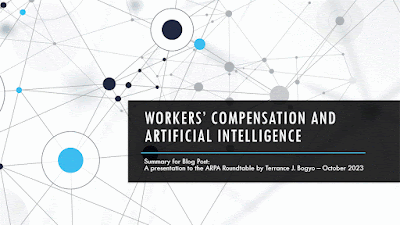The recent Australian Association of Rehabilitation Providers (ARPA) Roundtable meeting in Perth provided an opportunity to speak on how AI is and will impact workers’ compensation.
In my
presentation, I noted that AI has been applied in research and proprietary settings
for years but that the advent of low or no-barrier access to Large Language
Models such as ChatGPT, Bard, Bing’s chat, Perplexity, and others have quickened the pace of AI
application and adoption.
AI will not
change the functions of any disability insurance or workers’
compensation systems. Using Henry
Mintzberg’s approach, I illustrated how AI can be applied to functions in the
technostructure, support, and strategic apex of organizations, as well as
through the operating core. The impact
at the interface between the organization and those it serves (stakeholders,
injured workers, employers, advocates, etc.) is dynamic and
bi-directional. AI enables
organizational functions and changes how others outside the structure use,
analyze and react to information and decisions.
AON, one of
the world’s largest reinsurers, [see https://insights-north-america.aon.com/total-cost-of-risk/how-artificial-intelligence-is-changing-workers-compensation
] and
Clara Analytics [see https://claraanalytics.com/blog/six-ways-to-reduce-workers-comp-costs-using-ai/
].have reported current application of AI in the insurance and workers’
compensation sector. Applications that
include:
- Analyzing workers’ compensation wealth of structured and unstructured data
- Sorting out the impact of events like COVID-19
- Loss control benefits for employers
- Detect anomalies in procedures and drug costs
- Evaluate, decide, and pay 60-70% of straightforward claims
- Identifying high risk and complex cases early and direct to specialist staff
- Enable early intervention.
I demonstrated
how a complex 43-page appeal-level decision could be uploaded to a chatbot with
a prompt to produce a 500 word, plain-language summary along with the strengths
and weaknesses of the decision. The near
instantaneous output matched the quality of my own summary and analysis that
took more than half a day to prepare.
In another
example, I showed how AI had been trained to analyze and code a few thousand
workers’ compensation cases, apply that learning to a dataset of 1.2 million
cases and produce actionable analytics for prevention of injuries in specific
sectors.
A recent
IBM report [see https://www.ibm.com/thought-leadership/institute-business-value/en-us/report/augmented-workforce
noted “AI will not replace
people – but people who use AI will replace people who don’t.” Putting a finer point on this, I noted:
- AI won’t replace clinicians but clinicians who use AI will replace clinicians who don’t.
- AI won’t replace rehabilitation and return to work specialists but rehabilitation specialists who use AI will replace rehab professionals who don’t.
- AI won’t replace CEOs but CEOs who use AI will replace CEOs who don’t.
My final
points reiterated that AI is here, it is not going away, and it is going to
increase in power. Ignoring and fearing
it are not really options. Understanding
AI, how to use it, and its limitations is essential.
Workers’
compensation or disability insurance are not islands. As clients, injured workers, regulators, advocates,
and stakeholders adopt AI and experience how sectors and services using this
technology to improve quality and timeliness, they will demand improvements in
these sectors as well. Even if you are
meeting or exceeding your service, timeliness, and quality standards now, by
the measure of the AI-enabled world, you are falling behind. Your reputation and social capital will
suffer as a result.
The
discussion following the presentation included insightful questions and
observations. One key insight was the
importance of crafting the prompts used with large language models. The richness and accuracy of the prompts will
be somewhat determinant of the product of an AI interaction.
Also
covered in the discussion was the importance of the professionalism, knowledge,
and experience users bring to AI interactions.
At this point in AI implementation, those human insights and judgements
are essential. In one of the
presentation examples, the AI chatbot was prompted to read a case study from
the ARPA website and develop a specific multi-faceted rehabilitation plan for a
complex case. The output accurately reflected
what the current body of disability management and rehabilitation management knowledge
would ideally recommend. The realities
and constraints of implementing the plan, adapting the ideal to the specific
context, and “doing” the work required professional human judgement to achiever
the real-world objective of a safe, durable return-to-work outcome.
Another
comment built on the cautions raised in the presentation regarding privacy,
confidentiality, and regulatory issues. While all the examples used in my
presentation were from publicly available sources, professional judgement and rigorous
compliance with regulatory and professional standards will complicate
implementation of AI in organizations.
The call to
action for this presentation was engagement.
It is time to educate subject matter experts in all functional areas of
your organization about AI and begin the process of improving and safeguarding
functions across the organization.
AI will improve
workers’ compensation, disability management, personal injury insurance, and
prevention. Developing your AI strategy is not just something to put on your to
do list, it is a current imperative.


No comments:
Post a Comment